
Jagannath is a deity worshipped in regional traditions of Hinduism in India and Bangladesh. Jagannath is the 9th avatar of Vishnu. He is part of a triad along with his brother Balabhadra and sister Subhadra. To most Vaishnava Hindus, Jagannath is an abstract representation of Krishna; to some Shaiva and Shakta Hindus, he is a symmetry-filled tantric representation of Bhairava; to some Buddhists, he is a symbolic representation of the Buddha in the Buddha-Sangha-Dhamma triad; to some Jains, his name and his festive rituals are derived from Jeenanath of Jainism tradition.
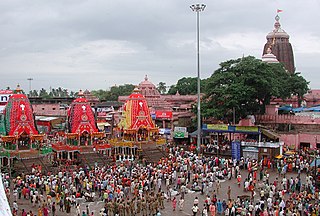
Ratha Yatra is a Hindu festival associated with Lord Jagannath held at Puri in the state of Odisha, India. It is the oldest Ratha Yatra taking place in India and the World, whose descriptions can be found in Brahma Purana, Padma Purana, and Skanda Purana and Kapila Samhita.

Puri is a city and a municipality in the state of Odisha in eastern India. It is the district headquarters of Puri district and is situated on the Bay of Bengal, 60 kilometres (37 mi) south of the state capital of Bhubaneswar. It is also known as Sri Jagannatha Dhama after the 12th-century Jagannatha Temple located in the city. It is one of the original Char Dham pilgrimage sites for Hindus.
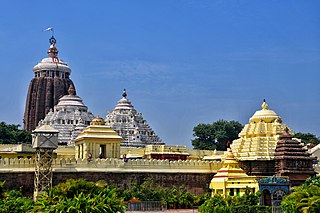
The Shree Jagannath Temple is an important Hindu temple dedicated to Jagannath, a form of Vishnu, in Puri in the state of Odisha on the eastern coast of India. The present temple was rebuilt from the 10th century onwards, on the site of an earlier temple, and begun by King Anantavarman Chodaganga Deva, first of the Eastern Ganga dynasty.

Mahima Dharma is an Indian religion practiced primarily in Odisha and nearby states. It was started by people from the underprivileged castes in a caste-based Hindu society as a social reform and protest against the dominance of Brahmanism. The religious movement was based on the condemnation of all religious customs set by the rich and upper-class society generally.
Satya Mahima Dharma is a religious tradition in Hinduism, from Orissa. It goes back to a historic person called Mahima Svami.
Anncharlott Eschmann was a scholar of religion.
Hermann Kulke is a German historian and Indologist, who was professor of South and Southeast Asian history at the Department of History, Kiel University (1988–2003). After receiving his PhD in Indology from Freiburg University in 1967, he taught for 21 years at the South Asia Institute of Heidelberg University (SAI).

In the Hindu epic Mahabharata, Navagunjara is a creature composed of nine different animals. The animal is a common motif in the Pata-Chitra style of painting, of the Indian state of Odisha. The beast is considered a form of the Hindu god Vishnu, or of Krishna, who is considered an Avatar (incarnation) of Vishnu. It is considered a variant of the virat-rupa form of Krishna, that he displays to Arjuna, as mentioned in the Bhagavad Gita, a part of the epic Mahabharata.
Lalita is a 1949 Indian folklore Oriya film directed by Kalyan Gupta.

The Char Dham is a set of four pilgrimage sites in India. It is believed that visiting these sites helps achieve moksha (salvation). The four Dhams are Badrinath, Dwaraka, Puri and Rameswaram. It is believed that every Hindu should visit the char dhams during one's lifetime. The Char Dham as defined by Adi Shankaracharya consists of four Hindu pilgrimage sites. Another small circuit in Uttarakhand of four pilgrimage sites-Yamunotri, Gangotri, Kedarnath, and Badrinath is referred to as Chota Char Dham.

Alarnatha Temple or Alvarnaatha ,(Oriya:ଅଲାରନାଥ) is a temple dedicated to Vishnu and located in Brahmagiri, Odisha, near Puri. It becomes crowded during the krishnapaksha of Ashadha, after the Snana Yatra when lord Jagannath cannot be seen in Puri. During this period, popularly known as Anasara or 'Anavasara', instead of having darshan in Jagannath Temple, peoples believe that Lord Jagannath during this time manifests as Alarnath Dev, at the Alarnath temple in Brahmagiri, which is about 23 km from Puri.

Chari Kshetra is a group of four holy regions in Odisha. When Vishnu killed the demon Gayasura, to commemorate the glory of his victory, he placed his Sankha (conch) in Puri, Chakra (disc) in Bhubaneswar, Gadaa (mace) in Jajpur and Padma (lotus) in Konark and they were known as Sankha Kshetra, Chakra Kshetra, Gada Kshetra and Padma Kshetra respectively.
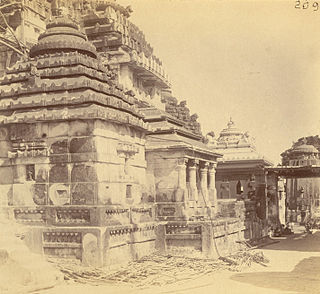
The Vimala Temple or Bimala Temple is a Hindu temple dedicated to goddess Vimala (Bimala), located within the Jagannath Temple complex in Puri in the Indian state of Odisha. It is generally regarded as a Shakti Pitha, among the holiest temples dedicated to the Hindu Goddess.
Nila Madhava is an idol that was in the possession of a tribal king, Biswabasu. Scriptures says that, after Lord Krishna wound up his manifested pastimes, he took a shape of Lord Vishnu. Biswabasu found this stone and felt its divinity. So he started worshiping it and name it Lord Nila Madhava. This brahma was later fetched by King Indradyumna by Brahmin Bidyapati for the creation of Lord Jagannath's idol. It has been kept inside a small chamber inside the Lords idol. It is believed that it is still present inside the Lord's idol and is transferred to the new idol after every 12 years.
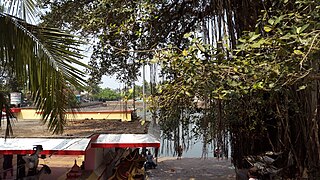
Hindus consider it essential to bathe in the Pancha Tirtha or the five sacred bathing spots of Puri, India, to complete a pilgrimage to Puri. The five sacred water bodies are:

Ratha Yatra, also known Ratha Jatra or Chariot festival. It is the biggest and oldest festival celebrated on the earth. On the Rathayatra festival the Deities from the main temple of Puri, Odisha are aboded on 3 decorated chariots and pulled by millions of devotees gathered from across the world and taken to their birth temple called Gundicha Temple. Lord Jagannatha is the Lord of the Universe, also known as the Purushottama or Param Brahmh, worshipped with Lord Balabhadra, Maha Devi Subhadra and Sudarshana Chakra at the Puri Shree Jagannath Temple in Odisha. this festival is observed across the world in more than 100 countries.

The 12875 / 12876 Neelachal Express is a tri-weekly train which runs between Puri in Odisha and Anand Vihar Terminal railway station. It is one of the oldest train that connects Puri to Anand Vihar Terminal. The main towns along the route are Bhubaneshwar, Cuttack,Bhadrak,Balasore, Hijili, Tatanagar, Bokaro Steel City, Muri, Gaya, Dehri, Sasaram Mughalsarai, Varanasi, Bhadohi, Rae Bareli, Lucknow, Unnao, Kanpur, Etawah, Firozabad, Hathras and Aligarh. It operates three times per week and covers a distance of 1,912 kilometres (1,188 mi) from Puri to Anand Vihar Terminal. Neelachal Express consist of 1 Second AC coach, 4 Third AC coaches, 12 Sleeper Class coaches, 2 General (Un-Reserved) coaches, 1 Pantry Car and 2 EOG.

The Saty Narayan Ji Temple in Nabha is a famous, sacred Hindu temple dedicated to Vishnu and located on the North of India, at Nabha in the state of Punjab.
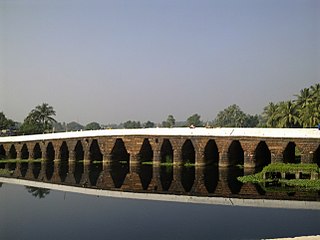
Atharanala - a historic laterite stone bridge over the Madhupur or Musa stream at the entrance to the city of Puri, Odisha (India) on Puri - Bhubaneswar road, locally known as Atharnala bridge; a Monument of National Importance N-OR-64 officially recognized by Archaeological Survey of India. Due to safety reasons the bridge is excluded from heavy vehicle traffic.















